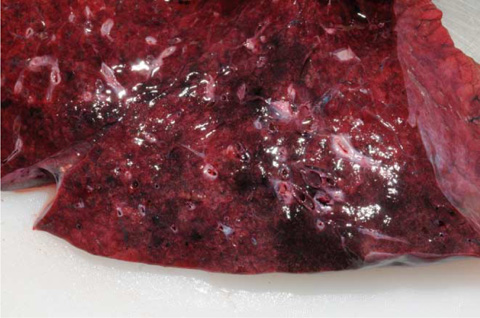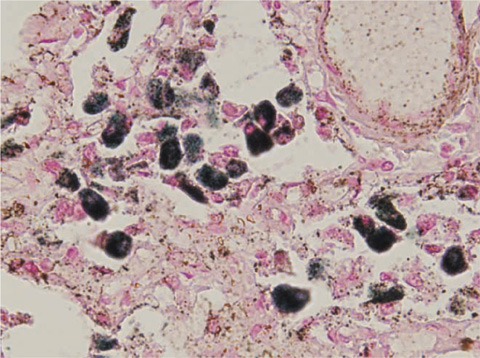Korean J Leg Med.
2012 May;36(1):97-101. 10.7580/KoreanJLegMed.2012.36.1.97.
Alveolar Siderophages : A Precipitating Factor in a Fatal Scuba Diving Accident?: An Autopsy Case
- Affiliations
-
- 1Department of Forensic Medicine, Chosun University School of Medicine, Gwang-ju, Korea. ysk007fm@hotmail.com
- KMID: 2250324
- DOI: http://doi.org/10.7580/KoreanJLegMed.2012.36.1.97
Abstract
- The author report the case of a 40-year-old male leisure scuba diver (height, 176 cm; weight, 73 kg) who died from asphyxiation by aspiration of gastric content, allegedly triggered by pulmonary hemosiderosis and/or full stomach. On the first dive of the day, the deceased complained of difficulty in descent and tried to descend several times but finally gave up and separated from his companions. After several minutes of separation, he was found dead, face down position on the sea surface, by the captain of the boat carrying the diving party. On autopsy, the lungs showed foreign bodies from stomach, intra-alveolar hemorrhage, and siderophages in the alveolar sac. A small amount of air bubbles was noted in the mesenteric vein, iliac artery, right ventricle and pulmonary artery. The cause of death was asphyxiation by aspiration of gastric content and pulmonary hemosiderosis, which probably provoked the event. Alveolar hemosiderosis may be a causal factor in fatal scuba diving accident.
Keyword
MeSH Terms
Figure
Reference
-
1. Taylor DM, O'Toole KS, Ryan CM. Experienced, Recreational Scuba Divers in Australia Continue to Dive Despite Medical Contraindications. Wilderness and Environmental Medicine. 2002. 13:187–193.2. Sim RJ, Youngs RP. Otolaryngological requirements for recreational self-contained underwater breathing apparatus (SCUBA) diving. J Laryngol Otol. 2007. 121:306–311.3. Bove AA. Brubakk AO, Neuman TS, editors. Fitness to Dive. Bennett and Elliott's Physiology and Medicine of Diving. 2003. 5th ed. Philadelphia: Saunders;700–717.4. Denoble PJ, Caruso JL, Dear GL, Vann RD. Common causes of open-circuit recreational diving fatalities. Undersea Hyperb Med. 2008. 35:393–406.5. Obafunwa JO, Busuttil A, Purdue B. Deaths of amateur scuba divers. Med Sci Law. 1994. 34:123–129.6. Obafunwa JO, Purdue B, Busuttil A. Endomyocardial fibrosis in a scuba diving death. J Forensic Sci. 1993. 38:1215–1221.7. Haydon JR, Williamson JA, Ansford AJ, Sherif A, Shapter MJ. A SCUBA-diving fatality. Med J Aust. 1985. 143:458–462.8. Plattner T, Thali MJ, Yen K, et al. Virtopsy - Postmortem Multislice Computed Tomography(MSCT) and Magnetic Resonance Imaging(MRI) in a Fatal Scuba Diving Incident. J Forensic Sci. 2003. 48:1347–1355.9. Ioachimescu OC, Stoller JK. Diffuse Alveolar Hemorrhage: Diagnosing it and finding the cause. Cleve Clin J Med. 2008. 75:258–280.10. Ioachimescu OC, Sieber S, Kotch A. Idiopathic pulmonary hemosiderosis revisited. Eur Respir J. 2004. 24:162–170.11. Noguchi TT, Moore SM. Scuba diving fatalities. Med Arts Sci. 1962. i6:81–87.12. Eckert WG. Tedeschi CG, Eckert WG, Tedeschi LG, editors. Injuries from increased atmospheric pressure. Forensic medicine: a study in trauma and environmental hazards. 1977. Philadelphia: WB Saunders;636–640.13. Luderwald S, Zinka B. Fatal diving accidents: Two case reports and an overview of the role of forensic examinations. Forensic Sci Int. 2008. 180:e1–e5.14. Kim YS. Forensic Review of Underwater Diving-Related Death. Korean J Leg Med. 2002. 26:17–26.15. Kim YS. Checklist for Forensic Investigation on Fatal SCUBA Diving Accidents. Korean J Leg Med. 2009. 33:107–110.
- Full Text Links
- Actions
-
Cited
- CITED
-
- Close
- Share
- Similar articles
-
- SCUBA Diving Fatality by Overweighted Belt: An Autopsy Case
- Checklist for Forensic Investigation on Fatal SCUBA Diving Accidents
- Technical Approach for the Postmortem Examination of SCUBA Diving Fatality
- Forensic Review of Underwater Diving-Related Death
- Anterior Choroidal Artery Territory Infarction due to Internal Carotid Artery Dissection Presumably Caused by Scuba Diving






